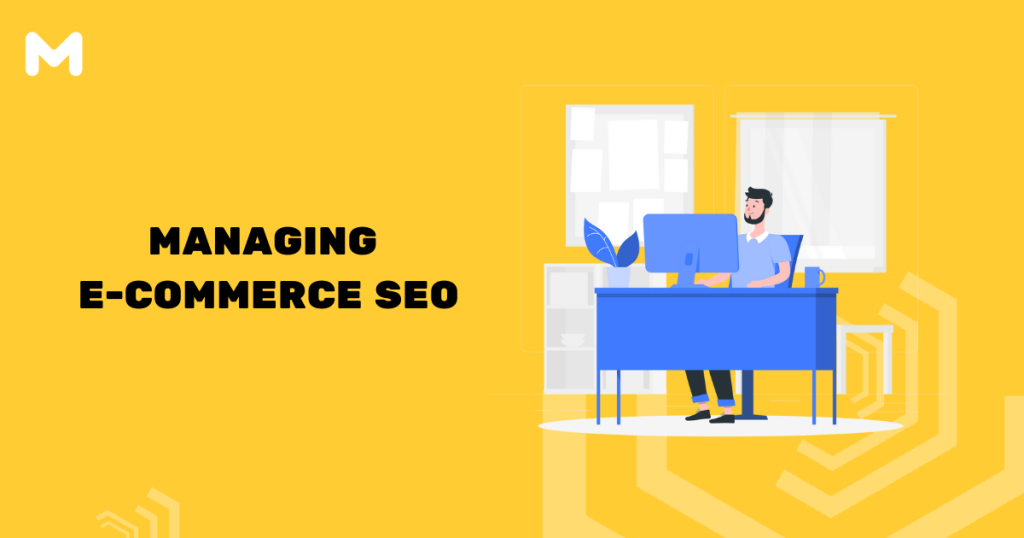Ecommerce SEO is the practice of improving organic rankings for online stores. And you need this to drive traffic to your E-commerce site. In fact, many people would argue that E-commerce stores need to focus even more on SEO for ranking and customer acquisition purposes. Ranking an E-commerce website is hard. You have to squeeze keywords into small descriptions, ensure that your website is user-friendly, check for lagging images, and more. SEO for e-commerce is not easy.
However, SEO for E-commerce is also necessary, especially if you have a new E-commerce business and website. So, it’s in your best interest to learn about the fundamentals of E-commerce and how to optimize your website for effective SEO.
What Is E-commerce SEO?
E-commerce SEO, or E-commerce Search Engine Optimization, is the process of increasing the quantity and quality of E-commerce website traffic that comes from search engines. This can be essential for a digital catalog, online store, and website.
And when we say quality, we mean how likely a visitor to your website is to take action. You may get a lot of traffic, but if that traffic isn’t transacting, it’s not high-quality.
We’ll be using Google as an example in this series, since almost 90% of global searches are Google searches.
To increase the quantity and quality of websites traffic means showing up higher in Google’s search results. And Google determines the order of search results using over 200 factors, or ranking signals.
The most substantial of those ranking signals are:
- Content relevancy and quality
- Page speed
- Website age and authority
- Publishing frequency
- User experience metrics (bounce rate, time on page, etc.) These are E-Commerce metrics.
- Mobile friendliness
- Logical website and content structure
How To Find Keywords For ECommerce Product And Category Pages
As mentioned earlier, the importance of product based keyword is well understood. We have various options and keyword research tools to get the valuable keyword.
- Google Ads Keyword Planner
- SEMScoop Keyword Research Tool
- Ahrefs Keyword Explorer
Factors To Consider When Selecting Keywords For Your ECommerce SEO
1. Search Volume
It depicts a number of people searching the content with that particular keyword. Which keyword is said to be favorable? The keyword is favourable when the search volume is high and buyer intent is clear. Keywords with higher commercial intent convert better. Commercial Intent is a parameter that focuses on:
“Transform the visitor into customers”. The keyword is said to be having great commercial intent when,
- It has high competition as per Keyword Planner
- Favorable “Top of Page Bid”.
Arrange Your Pages According To Their Priority
eCommerce SEO works well when you know which page of your website has a greater impact. The efficiency of the webpage is important to make your keyword rank higher. How could this be done?? To achieve this, it’s essential to consistently analyze your website’s traffic and conversion data to identify the pages driving the most engagement and sales. Optimizing these pages with targeted keywords, quality content, and internal linking can significantly boost their performance. However, be cautious of SEO manipulation techniques and detection measures, as search engines are becoming increasingly sophisticated at identifying and penalizing unethical practices.
Most Important pages have to be optimized first. This could be done by working on every section of your page.
Write SEO Friendly Short URLs.
Try to write short URLs and include your product name in the URL because it may help you to get better CTR. For example: Domain -> Category -> Sub- Category ->Product-Pages
URL Mapping For Keywords
It’s a process to find the most relevant page to target keywords. When the pages are arranged according to their priorities. Now, it’s the high time you assign the keyword to every page of the website.
As we already know, the keyword is not limited to one word, it could be a small phrase or a collection of two-three words. These are called short and long-tailed keywords. It’s the people’s way of finding their desired results. Do not be afraid to use “Long-tailed keywords” for their search. It comprises a huge share of searching strategies.
On Page SEO For Ecommerce Websites Keyword Optimization
On-page Optimization plays a crucial role in the successful build of any website. Any E-commerce website can only perform well if they are SEO optimized. The title of the page should be eye-catching and must consist of appropriate keywords. As mentioned earlier,
Product-based keywords are of great significant than any other keyword. The customer only goes for something which adjusts his criteria.
So include keywords, that are familiar to the customer’s speech of tongue.
- Cheap
- Free Shipping
- Best Deal
- Review
- Best Price
- Sales
In-Image Alt Text
As we know, Google is not able to read images. Alt-text is a description of an image given inside tag
Syntax:- Useful Tip: Don’t fill the alt tag with useless words or irrelevant keywords to rank high on Google. This is not what alt tags are made for and this may also trouble your visitors.
Metadata
It tells the user about the data. Metadata helps the Search Engine to recognize the content of the web page.
Types Of Metadata:
- Descriptive Metadata
- Structural Metadata
- Administrative Metadata
- Reference Metadata
- Statistical Metadata
The search engine uses the following meta-data:
1. Description: This metadata describes the content of the whole web page.
2. Title: This metadata tells about the topic the webpage is all about.
3. Keywords: This metadata is a matter of thought to most of the search engines, whether they include it or not.
Internal Linking
The links that connect with other pages of the same website are called internal links. These links are generally used to make the user navigate the entire website. The internal linking lets you:
- Increase the value of your website
- Increases the session time
- Decreases the bounce time
- Increase the ranking potential of every page of your site
Useful: Don’t add a huge number of internal links to your page, this will let Google algorithms decrease your position. Maximum 250 pages should be added to any page. The anchor tag is best suitable to develop a hierarchy between the web pages.
Use the tool Link Explorer to get the exact link structure of your website. Containing 1000’s links on the webpage may hinder your site’s performance as per Google’s algorithms. Linking should be done in such a way that, if Google’s spider navigates one of the pages on your website, then it should able to reach every page of your website.
The picture below shows the optimized way of internal linking in the website. The above type of linking is favourable to the user as well as to Google. Thus, we can come to the conclusion that Internal Linking has a huge impact on making SEO–Friendly websites.
Things to Beware in E-commerce SEO
Content Replication– A major issue resulting in an increased bounce rate. The user gets confused with the content and unable to find the worthy part of the content. Use the canonical link element to find where the main section of content resides.
Unrecognized Pages – The pages which are far away from the user’s or Google’s spider’s sight are good for nothing. These pages will never revert, whatever you have invested in them. This degrades the site’s SEO and results in decreased performance. Either delete these orphaned pages or bring them into the user’s vision.
No SSL – Encryption of a link between a web browser and the webserver is made using SSL technology. The site with SSL uses an extra “s” in HTTP in the site’s URL. Your action would definitely be, to skip that shop and get into another.
This will turn into “HTTPs” rather than “HTTP”. Fact: In 2004, Google announced that sites with HTTPS URLs will be given more priority than others. The site’s URL can be made HTTPS by installing an SSL certificate on your website.
How long will SEO last?
In implementing SEO, it takes about three to six months to see noticeable results. As far as how long SEO will be used, SEO has ongoing relevance for however long search engine results pages exist.
SEO provides dividends when your content is substantive, your links are properly structured, and you’re targeting relevant keywords. It takes some time to create blog posts that meet all of these requirements, but once they’re in place, you’ll start seeing traffic roll in.
Since search engine algorithms are always being updated, there’s always a need for SEO professionals to adapt content to it. Search engines are only expanding, which means SEO remains an essential marketing strategy into the foreseeable future.


